Abstract
Wilson disease (WD) is an autosomal recessive disorder due to the defect in ATP7B gene characterized by excessive accumulation of copper in the liver with progressive hepatic damage and subsequent redistribution to various extrahepatic tissues including the brain, kidneys, and cornea. Strikingly, the total serum copper concentration is always low in WD, even though the non-ceruloplasmin copper level is still expected to be high. To assess the role of free radical reactions catalyzed by non-ceruloplasmin copper, we investigated erythrocyte metabolism and oxidative stress as a mechanism for hemolysis in eight WD patients during episodes of acute hemolysis and compared them with eight follow-up cases of WD on d-penicillamine therapy and eight healthy, age-matched children. Elevated levels of non-ceruloplasmin copper were found in all the WD patients during an episode of hemolytic anemia. There was marked inhibition in erythrocyte enzymes, namely, hexokinase, total adenosine triphosphatase (ATPase), and glucose-6-phosphate dehydrogenase (G-6-PD) from WD patients compared with patients on penicillamine and healthy children, indicating altered erythrocyte metabolism during a hemolytic crisis. Antioxidant status was also found to be compromised as is evident from decreased glutathione (GSH) levels, decreased antioxidant enzymes (namely, superoxide dismutase, catalase, glutathione peroxidase, and glutathione reductase), increased lipid peroxidation, and deranged plasma antioxidants. Uric acid showed maximum decrease followed by ascorbic acid. These findings suggest that the free radical production by elevated non-ceruloplasmin copper through transition metal catalyzed reactions leads to oxidative injury resulting in altered erythrocyte metabolism and severely compromised antioxidant status of WD patients during hemolytic anemia.
Similar content being viewed by others
Log in or create a free account to read this content
Gain free access to this article, as well as selected content from this journal and more on nature.com
or
Abbreviations
- G-6-PD:
-
glucose-6 phosphate dehydrogenase
- GSH:
-
reduced glutathione
- TRAP:
-
total radical trapping antioxidant parameter
- WD:
-
Wilson disease
References
Scheinberg IH, Sternlieb I 1984 Wilson's Disease. WB Saunders, Philadelphia, pp 25–37
Petrukhin K, Fischer SG, Pirastu M, Tanzi RE, Chernov I, Devoto M, Brzustowicz LM, Cayanis E, Vitale E, Russo JJ 1993 Mapping, cloning and genetic characterization of the region containing the Wilson disease gene. Nat Genet 5: 338–343
Stremmel W, Meyerrose KW, Niederau C, Hefter H, Kreuzpaintner G, Strohmeyer G 1991 Wilson disease: clinical presentation, treatment, and survival. Ann Intern Med 115: 720–726
Deiss A, Lee GR, Cartwright GE 1970 Hemolytic anemia in Wilson's disease. Ann Intern Med 73: 413–418
Forman SJ, Kumar KS, Redeker AG, Hochstein P 1980 Hemolytic anemia in Wilson disease: clinical findings and biochemical mechanisms. Am J Hematol 9: 269–275
Boulard M, Blume KG, Beutler E 1972 The effect of copper on red cell enzyme activities. J Clin Invest 51: 459–461
Feig SA, Segel GB, Shohet SB, Nathan DG 1972 Energy metabolism in human erythrocytes II. Effect of glucose depletion. J Clin Invest 51: 1547–1554
Bavdekar AR 2004 Therapeutic and management challenges in Wilson's Disease. J Gastroenterol Hepatol 19: S391–S395
Tanaka R, Nakai K 1977 Hemolysis and morphological changes in rat erythrocytes with mercurials. Jpn J Pharmacol 27: 413–419
Tashima Y 1975 Removal of protein interference in Fiske-Subbarow method by sodium dodecyl sulphate. Anal Biochem 69: 410–414
Beutler E 1984 Red Cell Metabolism: A Manual of Biochemical Methods. Grune and Stratton, Orlando, FL, pp 38–39
Varley H, Gowenlock AH, Bell M 1980 Glucose-6-phosphate dehydrogenase. In: Varley H, Gowenlock A (eds) Varley's Practical Clinical Biochemistry. Whitefriar Press, Tonbridge, pp 729–731
Beutler E, Duron O, Kelly BM 1963 Improved method for the determination of blood glutathione. J Lab Clin Med 61: 882–888
Jain SK 1988 Evidence for membrane lipid peroxidation during the in vivo aging of human erythrocytes. Biochim Biophys Acta 937: 205–210
Kono Y 1978 Generation of superoxide radical during autooxidation of hydroxylamine and an assay for superoxide dismutase. Arch Biochem Biophys 186–189
Luck H 1963 A spectrophotometric method for the estimation of catalase. In: Bergmeyer HV (ed) Methods of Enzymatic Analysis. Verlag Chemie, Weinheim, pp 886–888
Flohe L, Gunzler WA 1984 Assays of glutathione peroxidase. Methods Enzymol 105: 114–121
Carlberg I, Mannervik B 1985 Glutathione reductase. In: Meister A (ed) Methods in Enzymology. Academic Press, New York, pp 484–490
Roe JM, Kuether CA 1943 Detection of ascorbic acid in whole blood and urine through the 2,4-DNPH derivative of dehydroascorbic acid. J Biol Chem 147: 399–407
Duncan PH, Gochman N, Cooper T, Smith E, Bayse D 1982 A candidate reference method for uric acid in serum. I. Optimization and evaluation. Clin Chem 28: 284–290
Sedlak J, Lindsay RH 1968 Estimation of total, protein-bound and nonprotein sulfhydryl groups in tissue with Ellman's reagent. Anal Biochem 25: 192–205
Lee BL, Chua SC, Ong HY, Ong CN 1992 High-performance liquid chromatographic method for routine determinations of vitamins A and E and beta-carotene in plasma. J Chromatogr 581: 41–47
Lindeman JH, van Zoeren-Grobben D, Schrijver J, Speek AJ, Poorthuis BJ, Berger HM 1989 The total free radical trapping ability of cord blood plasma in preterm and term babies. Pediatr Res 26: 20–24
Ravin HA 1961 An improved colorimetric enzymatic assay of ceruloplasmin. J Lab Clin Med 58: 161–168
Prasad R, Kaur G, Walia BN 1998 A critical evaluation of copper metabolism in Indian Wilson's disease children with special reference to their phenotypes and relatives. Biol Trace Elem Res 63: 153–155
Rother RP, Bell L, Hillmen P, Gladwin MT 2005 The clinical sequelae of intravascular hemolysis and extracellular plasma hemoglobin: a novel mechanism of human disease. JAMA 293: 1653–1662
Hoshino T, Kumasaka K, Kawano K, Yamagishi F, Koyama I, Fujimori-Arai Y, Nakajima T, Komoda T 1995 Low serum alkaline phosphatase activity associated with severe Wilson's disease. Is the breakdown of alkaline phosphatase molecules caused by reactive oxygen species?. Clin Chim Acta 238: 91–100
Bowler K, Duncan CJ 1970 The effect of copper on membrane enzymes. Biochim Biophys Acta 196: 116–119
Lai JC, Blass JP 1984 Neurotoxic effects of copper: inhibition of glycolysis and glycolytic enzymes. Neurochem Res 9: 1699–1710
Palamanda JR, Kehrer JP 1993 Involvement of vitamin E and protein thiols in the inhibition of microsomal lipid peroxidation by glutathione. Lipids 28: 427–431
Halliwell B, Gutteridge JM 1984 Oxygen toxicity, oxygen radicals, transition metals and disease. Biochem J 219: 1–14
Ogihara H, Ogihara T, Miki M, Yasuda H, Mino M 1995 Plasma copper and antioxidant status in Wilson's disease. Pediatr Res 37: 219–226
von Herbay A, de Groot H, Hegi U, Stremmel W, Strohmeyer G, Sies H 1994 Low vitamin E content in plasma of patients with alcoholic liver disease, hemochromatosis and Wilson's disease. J Hepatol 20: 41–46
Hochstein P, Kumar KS, Forman SJ 1980 Lipid peroxidation and the cytotoxicity of copper. Ann N Y Acad Sci 355: 240–248
Blum J, Fridovich I 1985 Inactivation of glutathione peroxidase by superoxide radical. Arch Biochem Biophys 240: 500–508
Blech DM, Borders CL Jr 1983 Hydroperoxide anion, HO−2, is an affinity reagent for the inactivation of yeast Cu, Zn superoxide dismutase: modification of one histidine per subunit. Arch Biochem Biophys 224: 579–586
Halliwell B, Gutteridge JM 1990 The antioxidants of human extracellular fluids. Arch Biochem Biophys 280: 1–8
Spitsin S, Hooper DC, Leist T, Streletz LJ, Mikheeva T, Koprowskil H 2001 Inactivation of peroxynitrite in multiple sclerosis patients after oral administration of inosine may suggest possible approaches to therapy of the disease. Mult Scler 7: 313–319
Langley SC, Brown RK, Kelly FJ 1993 Reduced free-radical trapping capacity and altered plasma antioxidant status in cystic fibrosis. Pediatr Res 33: 247–250
Author information
Authors and Affiliations
Corresponding author
Additional information
This work was supported by Indian Council of Medical Research (63/167/2001-BMS), New Delhi, India.
Rights and permissions
About this article
Cite this article
Attri, S., Sharma, N., Jahagirdar, S. et al. Erythrocyte Metabolism and Antioxidant Status of Patients with Wilson Disease with Hemolytic Anemia. Pediatr Res 59, 593–597 (2006). https://doi.org/10.1203/01.pdr.0000203098.77573.39
Received:
Accepted:
Issue date:
DOI: https://doi.org/10.1203/01.pdr.0000203098.77573.39
This article is cited by
-
Oral Administration of Copper Chloride Damages DNA, Lowers Antioxidant Defense, Alters Metabolic Status, and Inhibits Membrane Bound Enzymes in Rat Kidney
Biological Trace Element Research (2023)
-
Time course of pulmonary inflammation and trace element biodistribution during and after sub-acute inhalation exposure to copper oxide nanoparticles in a murine model
Particle and Fibre Toxicology (2022)
-
Copper chloride inhibits brush border membrane enzymes, alters antioxidant and metabolic status and damages DNA in rat intestine: a dose-dependent study
Environmental Science and Pollution Research (2021)
-
WilsonGen a comprehensive clinically annotated genomic variant resource for Wilson’s Disease
Scientific Reports (2020)
-
Copper(II) generates ROS and RNS, impairs antioxidant system and damages membrane and DNA in human blood cells
Environmental Science and Pollution Research (2019)



